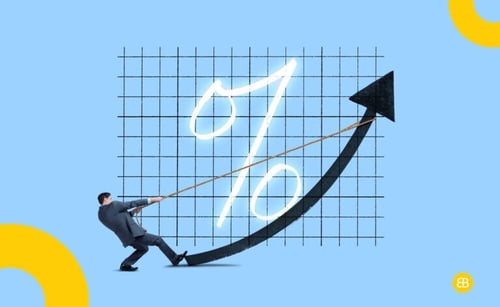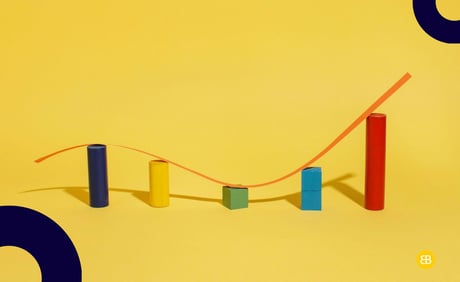Table of Contents
When it comes to website analytics, the website bounce rate is a crucial performance and user engagement metric.
Often underestimated, it holds the key to understanding how visitors interact with your website and why they might be leaving without taking the desired action (e.g., completing a purchase, or subscribing to your newsletter).
In this article, we look at the meaning of a high bounce rate, its implications, and actionable strategies to reduce it for improved user engagement and conversion rates.
Beyond the First Impression: Understanding Your Website Bounce Rate
As online users, we're all familiar with the rapid decisions we make when landing on a website. Within a few seconds, we determine whether the content aligns with our needs or interests.
This critical moment, known as the "first impression," directly influences the bounce rate.
But what exactly is the bounce rate?

Bounce rate is a vital web metric that quantifies the percentage of visitors who navigate away from your website after only one page.
The ideal bounce rate for a website falls between 26% and 40%. While the range can vary from 26% to 70%, the lower the bounce rate, the better the engagement with your visitors.
It's necessary to note that the bounce rate measures single-page sessions and reflects user engagement on individual pages, whereas the average bounce rate can tell us more about site appeal and content relevance.

Why Does The Website Bounce Rate Matter?
When you notice high bounce rates on your website, it could mean that users are not fully engaged or having trouble finding what they are looking for. Here's how you can interpret the bounce rate metric for your website:
User Engagement
The bounce rate serves as a barometer of user engagement. A low bounce rate often means that your visitors enjoy consuming content and interacting with your website beyond a single-page session. Conversely, a high bounce rate signifies a missed opportunity for engagement.
User Experience
The bounce rate also sheds light on the user experience (UX) your website offers. An unresponsive design or confusing navigation may lead to a higher bounce rate. Therefore, monitoring and improving the UX can lead to a lower bounce rate and increased user satisfaction.
Conversion Impact
In the end, the main goal for most businesses is to convert their website visitors into customers. A high bounce rate can hinder this goal by preventing users from progressing through the conversion funnel. By addressing the factors contributing to the bounce rate, you can enhance the likelihood of conversions, therefore boosting your website's overall effectiveness.
Check out our article "How to Reduce Your Bounce Rate to Increase Conversions" for more tips and tricks on how to reduce your website bounce rate while boosting your conversion rate.

Factors Contributing to High Bounce Rates
Understanding why visitors bounce is crucial for coming up with effective strategies to reduce the bounce rate in the long run. Several factors contribute to high website bounce rates, including:
- Relevance: If the content or offerings on your landing page don't align with visitors' expectations, they're likely to bounce.
- Loading Speed: Slow-loading pages may often confuse and even annoy users, driving them away. Stay ahead of your competitors with fast-loading pages.
- Design and Navigation: A cluttered or confusing design, as well as poor website navigation, can discourage users from exploring further.
- Mobile Compatibility: As there are 6.92 billion smartphone users worldwide and with mobile devices accounting for a significant portion of web traffic, the lack of mobile optimisation can lead to high bounce rates.
How To Reduce The Website Bounce Rate?
Reducing the bounce rate requires patience and dedication — expecting overnight results may discourage you from taking further action. Fortunately, there are some simple steps you can take to enhance your web pages and provide a better user experience long-term, including:
Improve Content Quality
Compelling content is your best weapon against a high bounce rate. Make sure your website content is relevant and valuable to your target user base. Add eye-catching visuals, informative headings, and concise yet informative text to capture visitors' attention and encourage them to stay longer.
Enhance Page Load Speed
The importance of fast-loading pages cannot be overstated. Optimise images and media content, leverage browser caching, and reduce code bloat to optimise your website's loading speed. A fast-loading page is more appealing to visitors and can positively impact search engine rankings.
We recommend to regularly check your page speed using tools such as:
- Google PageSpeed Insights
- WebPageTest
- Uptrends
- GTmetrix
- Pingdom

Focus On The User Experience
Prioritise user experience by employing a responsive design that adapts to various devices and screen sizes. Streamline navigation, place important content prominently, and eliminate any elements that might distract or confuse users.
Leverage Internal Linking
Guide visitors to explore more of your website's content by strategically placing internal links within your articles and pages. This not only keeps users engaged but also improves your website's overall SEO by distributing authority across pages.
Perform A/B Tests
Experimentation is key to finding what resonates with your audience. Perform A/B tests (or split testing) on various website elements, including headings, layouts, and Call-To-Action (CTA) buttons. Data-driven insights from these tests can lead to informed decisions for reducing the bounce rate.
Optimise Landing Pages
Landing pages are often the first touchpoints for users. Create custom landing pages that align with your marketing campaign goals and target specific keywords. Tailor the content to match users' search intent, ensuring a seamless transition from their search query to your page.

Frequently Asked Questions
What is a “good” website bounce rate?
Is a high bounce rate “bad” for my website?
Are the bounce rate metric and the exit rate the same?
Bounce rate, as found in Google Analytics, reflects single-page sessions, indicating the site’s engagement level. In contrast, the exit rate looks ar the frequency of visitors leaving, considering all sessions.

Conclusion
The bounce rate is more than just a number — it's a window into your website's effectiveness and user satisfaction.
By understanding the factors contributing to a high bounce rate and implementing strategies to address them, you can create a more engaging user experience, enhance conversions, and ultimately achieve your business goals.
Remember, reducing the website bounce rate requires a holistic approach that combines relevant and engaging content, efficient design, and continuous optimisation. Find out how EB Pearls can help you build a website that converts. Contact us and we'll get back to you with a detailed quote.

Renji strives for excellence, inspiring teams to grow and improve both professionally and personally, fostering motivation in and outside of work.
Read more Articles by this Author
